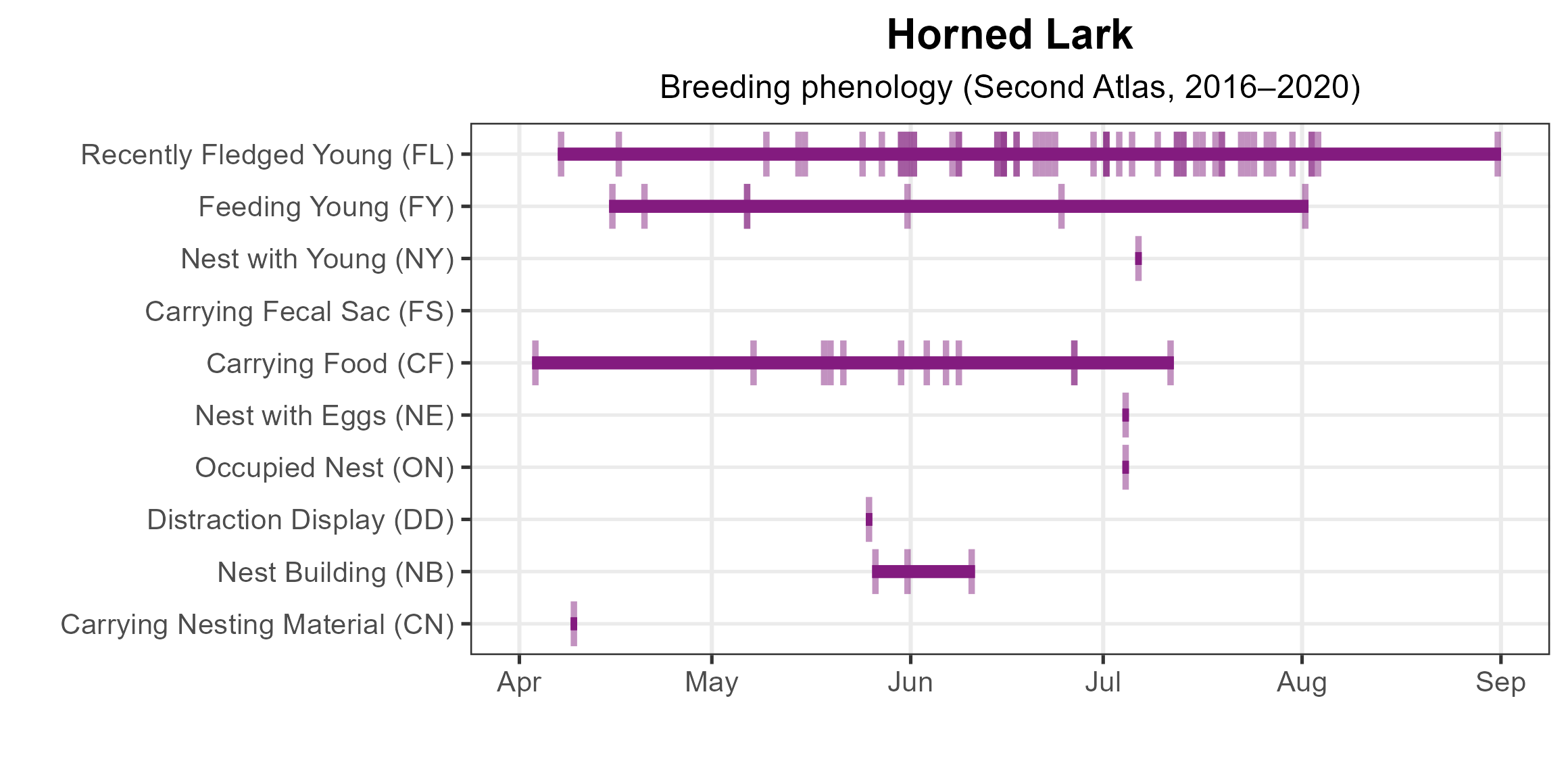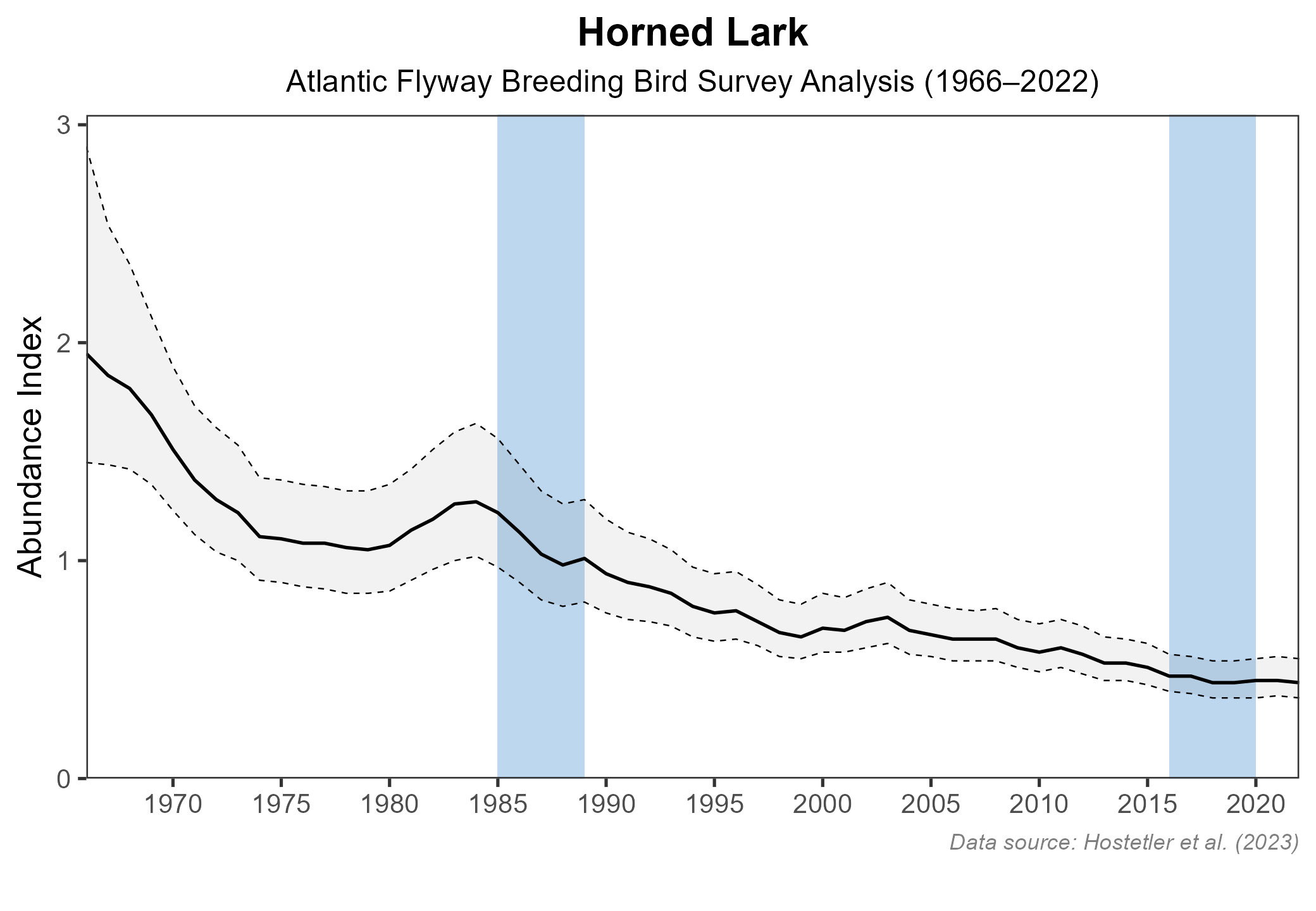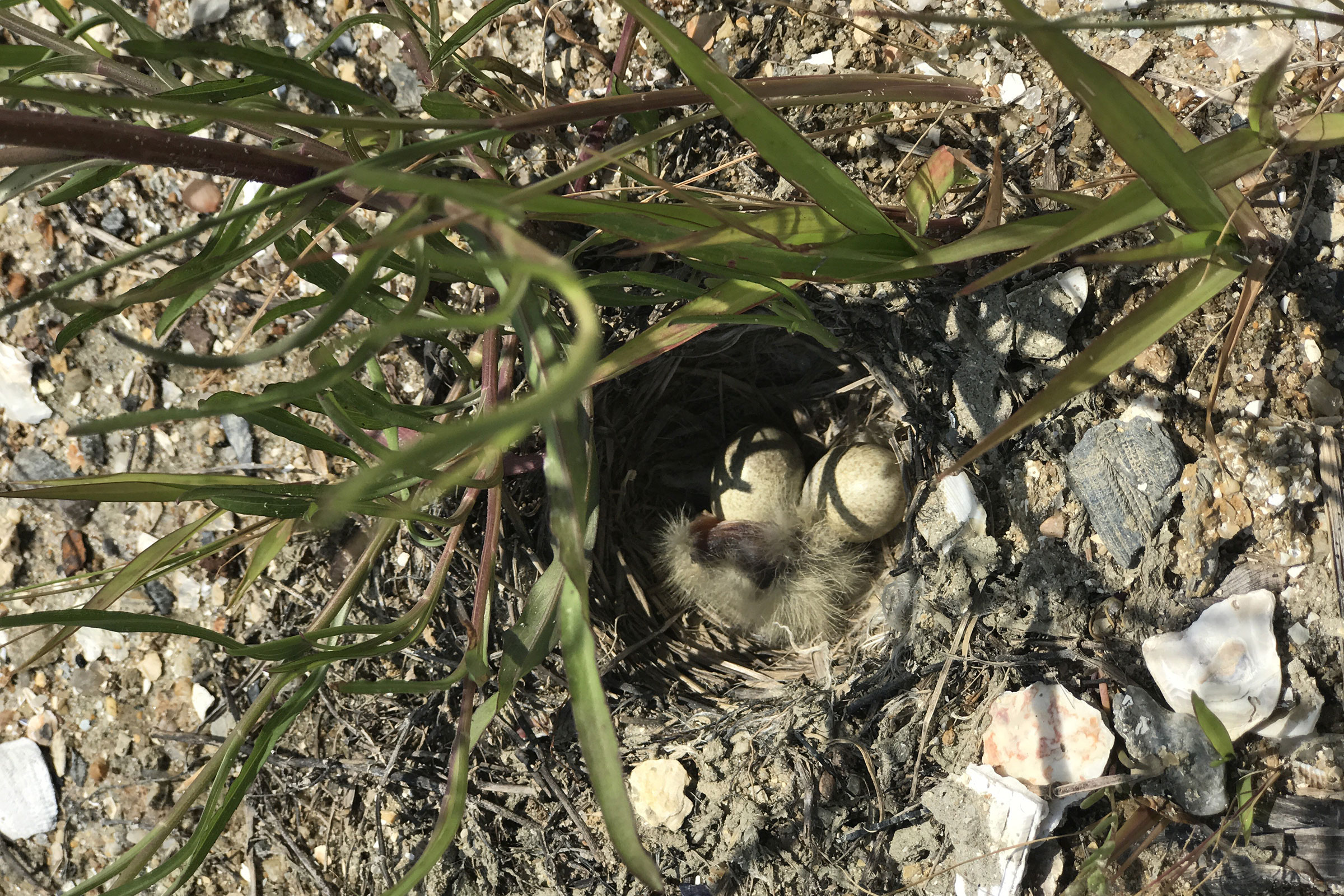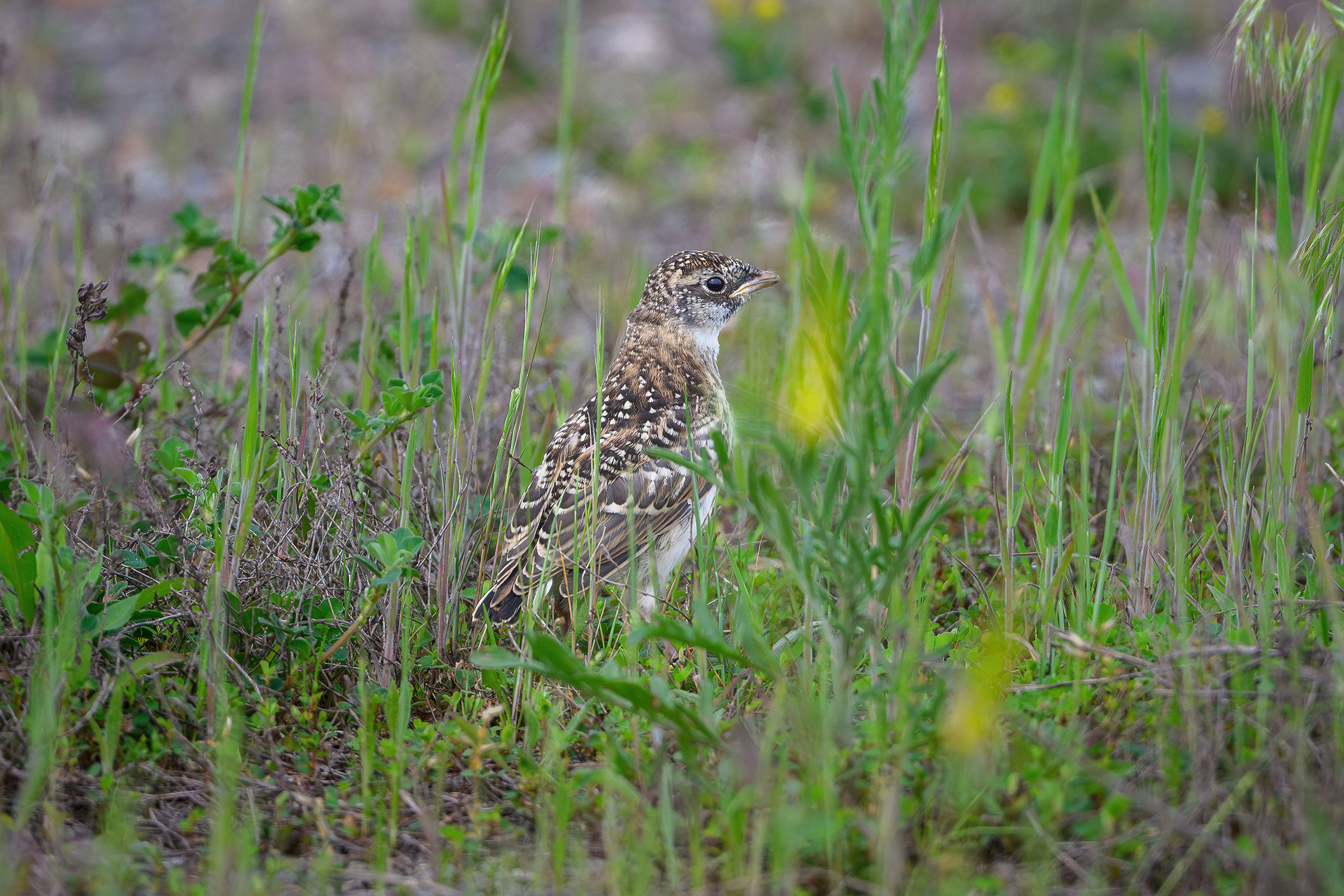Introduction
Although Horned Larks occur throughout Virginia, they often go unnoticed. These small “earth-colored” birds nest and feed in the most open and barren of habitats, where their plumage provides natural camouflage. They nest on bare ground or in places with short, sparse vegetation, such as grass and forbs. In Virginia, they find these conditions on heavily grazed pastures, at the edges of plowed fields, and areas where grass is kept very short through regular mowing (e.g., aircraft landing strips) (Beason 2020).
Breeding Distribution
Horned Larks are uncommon but breed in all regions of Virginia, and they are moderately likely to occur on the Eastern Shore, in the southern Coastal Plain and along the region’s major rivers, in the northern and southern Piedmont, and in the northern Mountains and Valleys region (Figure 1). Specifically, Horned Larks are more likely to occur in blocks with a greater amount of agricultural cover (which includes hay fields, pastures, and row crops) and grassland habitat and a greater number of habitat types. In contrast, they are less likely to occur in blocks with a high percentage of forest cover and a greater amount of forest edge habitat.
Between the First and Second Atlases (Figures 1 and 2), the Horned Lark’s likelihood of occurrence decreased throughout much of the Mountains and Valleys region and the northwestern portion of the Piedmont region (Figure 3). These declines in probable occurrence are likely associated with changes in farming practices, such as moving away from farms with pastures toward more intensive row-crop farming. Throughout the remainder of the state, its occurrence remained the same.

Figure 1: Horned Lark breeding distribution based on probability of occurrence (Second Atlas, 2016–2020). This map indicates the probability that this species will occur in an Atlas block (an approximately 10 mi2 [26 km2] survey unit) based on environmental (including habitat) factors and after adjusting for the probability of detection (variation in survey effort among blocks).

Figure 2: Horned Lark breeding distribution based on probability of occurrence (First Atlas, 1985–1989). This map indicates the probability that this species will occur in an Atlas block (an approximately 10 mi2 [26 km2] survey unit) based on environmental (including habitat) factors and after adjusting for the probability of detection (variation in survey effort among blocks). Blocks in white were not surveyed during the First Atlas and were not modeled.

Figure 3: Horned Lark change in breeding distribution between Atlases (1985–1989 and 2016–2020) based on probability of occurrence. This map indicates the change in the probability that this species will occur in a block (an approximately 10 mi2 [26 km2] survey unit) between Atlas periods. Blocks with no change (tan) may have constant presence or constant absence. Blocks in white were not surveyed during the First Atlas and were not modeled.
Breeding Evidence
Horned Larks were confirmed breeders in 55 blocks and 38 counties and probable breeders in an additional 15 counties (Figure 4). These breeding observations were primarily recorded in the Coastal Plain and Piedmont regions. During the First Atlas, breeding observations were more widespread in the Mountains and Valleys region, while there were fewer observations in the Coastal Plain region than during the Second Atlas (Figure 5). However, it is also important to note that survey effort was considerably less during the First Atlas.
The earliest confirmed breeding behavior was recorded on April 3, when adults were observed carrying food. Additional breeding evidence was confirmed through observations of recently fledged young (April 7 – August 31) and adults feeding young (April 15 – August 1) (Figure 6). For more general information on the breeding habits of this species, please refer to All About Birds.

Figure 4: Horned Lark breeding observations from the Second Atlas (2016–2020). The colored boxes illustrate Atlas blocks (approximately 10 mi2 [26 km2] survey units) where the species was detected. The colors show the highest breeding category recorded in a block. The numbers within the colors in the legend correspond to the number of blocks with that breeding evidence category.

Figure 5: Horned Lark breeding observations from the First Atlas (1985–1989). The colored boxes illustrate Atlas blocks (approximately 10 mi2 [26 km2] survey units) where the species was detected. The colors show the highest breeding category recorded in a block. The numbers within the colors in the legend correspond to the number of blocks with that breeding evidence category.

Figure 6: Horned Lark phenology: confirmed breeding codes. This graph shows a timeline of confirmed breeding behaviors. Tick marks represent individual observations of the behavior.
Population Status
The relative abundance of Horned Larks was estimated to be highest throughout much of the Coastal Plain, especially in the far southeastern corner and on the Eastern Shore (Figure 7). Abundance levels were also moderate in the northwestern Piedmont region.
The total estimated Horned Lark population in the state is approximately 30,000 individuals (with a range between 9,000 and 124,000). Based on the North American Breeding Bird Survey (BBS), the Horned Lark population experienced a significant decline of 2.6% annually from 1966–2022 in Virginia, and between Atlases, its population decreased by a similar significant 2.7% per year from 1987–2018 (Hostetler et al. 2023; Figure 8).

Figure 7: Horned Lark relative abundance (Second Atlas, 2016–2020). This map indicates the predicted abundance of this species at a 0.4 mi2 (1 km2) scale based on environmental (including habitat) factors. Abundance values are presented on a relative scale of low to high.

Figure 8: Horned Lark population trend for the Atlantic Flyway as estimated by the North American Breeding Bird Survey. The vertical axis shows species abundance; the horizontal axis shows the year. The solid line indicates the estimated population trend; there is a 97.5% probability that the true population trend falls between the dashed lines. The shaded bars indicate the First and Second Atlas periods.
Conservation
The Horned Lark has experienced decreases in the state. Its decline is likely due to the loss of agricultural lands to reforestation efforts or development and to shifts in agricultural practices (Beason 2020). This species prefers grasslands with sparse and low vegetation; thus, practices that involve mowing, burning, or grazing could be helpful in maintaining suitable habitat (Dinkins et al. 2019). To address these changes, Virginia’s 2025 Wildlife Action Plan includes the Horned Lark as a Tier III Species of Greatest Conservation Need (High Conservation Need), indicating that this species is in decline and conservation actions are needed to stabilize it within the state (VDWR 2025).
Interactive Map
The interactive map contains up to six Atlas layers (probability of occurrence for the First and Second Atlases, change in probability of occurrence between Atlases, breeding evidence for the First and Second Atlases, and abundance for the Second Atlas) that can be viewed one at a time. To view an Atlas map layer, mouse over the layer box in the upper left. County lines and physiographic regional boundaries (Mountains and Valleys, Piedmont, and Coastal Plain) can be turned on and off by checking or unchecking the box below the layer box. Within the map window, users can hover on a block to see its value for each layer and pan and zoom to see roads, towns, and other features of interest that are visible beneath a selected layer.
View Interactive Map in Full Screen
References
Beason, R. C. (2020). Horned Lark (Eremophila alpestris), version 1.0. In Birds of the World (S. M. Billerman, Editor). Cornell Lab of Ornithology, Ithaca, NY, USA. https://doi.org/10.2173/bow.horlar.01.
Dinkins, M.F., L. D. Igl, J. A. Shaffer, D. H. Johnson, A. L. Zimmerman, B. D. Parkin, C. M. Goldade, and B. R. Euliss (2019). The effects of management practices on grassland birds—Horned Lark (Eremophila alpestris), version 1.1. In The effects of management practices on grassland birds (Johnson, D.H., Igl, L.D., Shaffer, J.A., and DeLong, J.P., Editors). U.S. Geological Survey Professional Paper 1842. https://doi.org/10.3133/pp1842U.
Hostetler, J. A., J. R. Sauer, J. E. Hines, D. Ziolkowski, and M. Lutmerding (2023). The North American breeding bird survey, analysis results 1966–2022. U.S. Geological Survey, Laurel, MD, USA. https://doi.org/10.5066/P9SC7T11.
Virginia Department of Wildlife Resources (VDWR) (2025). Virginia wildlife action plan. Virginia Department of Wildlife Resources, Henrico, VA, USA. 506 pp.





